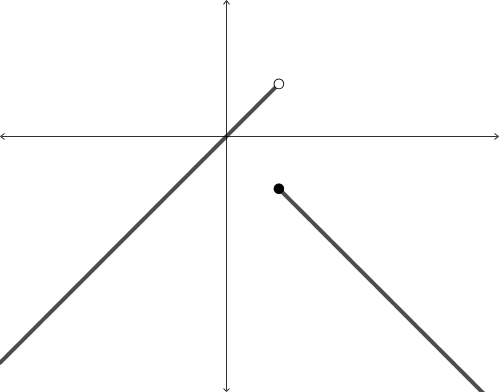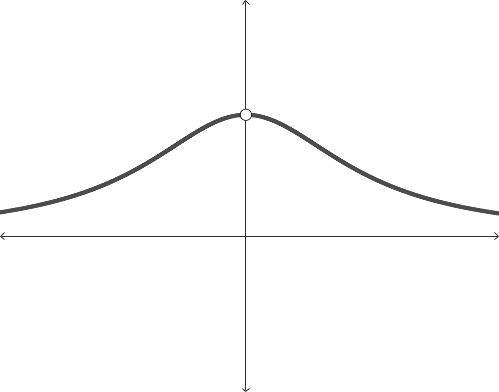Since we’ll want to label functions at places that they are not continuous (in order to write the intervals where it
is continuous), we should summarize some things about discontinuities.
Example 1.6.5.
Let’s revisit the same function we looked at earlier:
\begin{equation*}
f(x) = \begin{cases}
2x+1 \amp \text{when } x\leq 2\\
\dfrac{2x^2+7}{3} \amp \text{when } 2\lt x \lt 4\\
\dfrac{6}{x-1} + 3 \amp \text{when } x\geq 4
\end{cases}
\end{equation*}
We already looked at what was happening at
\(x=2\) and
\(x=4\text{.}\) Are there any other
\(x\)-values where this function might not be continuous? Why or why not? Can you report the intervals on which
\(f(x)\) is continuous?
Hint.
Can you name the function type for
\(x\lt 2\text{,}\) \(2\lt x\lt 4\) and
\(x\gt 4\text{?}\)
Solution.
Since
\(f(x)\) is polynomial for
\(x\lt 2\) and
\(2\lt x\lt 4\text{,}\) we know that the function is continuous on those intervals as well. We can see that for
\(x\gt 4\text{,}\) \(f(x)\) is a rational function. Since the only
\(x\)-value where we might divide by 0 is outside of the interval for which this function part is defined, we know that this function is continuous for
\(x\gt 4\text{.}\)
Since our function is continuous at
\(x=2\text{,}\) we can say that it is continuous on the interval
\((-\infty, 4)\text{.}\) We also say that the function was continuous on the right at
\(x=4\text{,}\) and so we can say that
\(f(x)\) is also continuous on the interval
\([4,\infty)\text{.}\)
We’ll end this section with one last result that will be pretty important. Continuity, as a property, will be useful as we move forward, but only for a few specific reasons. One is the following result.
Let’s evaluate the following limit:
\begin{equation*}
\lim_{x\to 1}\left(\sin\left(\sqrt{e^{x^2-2x+1}}\right)\right)\text{.}
\end{equation*}
Notice that the sine function is continuous everywhere. This means that we can bring the limit statement “inside” by a layer:
\begin{equation*}
\lim_{x\to 1}\left(\sin\left(\sqrt{e^{x^2-2x+1}}\right)\right) = \sin\left(\lim_{x\to 1}\sqrt{e^{x^2-2x+1}}\right)\text{.}
\end{equation*}
Now we can think about the square root function: we know that the radicand function (the exponential) always produces positive outputs. So we can bring the limit statement “inside” by another layer of composition:
\begin{equation*}
\sin\left(\lim_{x\to 1}\sqrt{e^{x^2-2x+1}}\right) = \sin\left(\sqrt{\lim_{x\to 1}e^{x^2-2x+1}}\right)\text{.}
\end{equation*}
The exponential function is also continuous everywhere:
\begin{equation*}
\sin\left(\sqrt{\lim_{x\to 1}e^{x^2-2x+1}}\right) = \sin\left(\sqrt{e^{\lim_{x\to 1}x^2-2x+1}}\right)\text{.}
\end{equation*}
And we also know that polynomial functions are continuous everywhere!
\begin{align*}
\sin\left(\sqrt{e^{\lim_{x\to 1}x^2-2x+1}}\right) \amp = \sin\left(\sqrt{e^{(1)^2-2(2)+1}}\right) \\
\amp = \sin\left(\sqrt{e^0}\right)\\
\amp = \sin(1)
\end{align*}
This seemingly difficult limit is actually as easy as just evaluating the function at the input, since the function behaves nicely.






